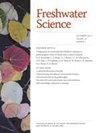Benthic metabolism and nutrient uptake vary with geomorphology and season in a lowland river
IF 1.6
4区 环境科学与生态学
Q3 ECOLOGY
引用次数: 0
Abstract
Meandering rivers are characterized by geomorphic units like cut banks, point bars, and thalwegs. These units arise from interactions between hydrological and geomorphological forces. However, the individual contributions of geomorphic units to whole-river metabolism or nutrient processing are unclear because these quantifications are often done at larger spatial scales. We used closed recirculating chambers to measure benthic gross primary production (GPP), respiration (R), N uptake or release, and P uptake or release at bimonthly intervals over 1 y at different geomorphic units in the Mulde River, Germany. We compared GPP, R, and nutrient processing among a cut bank, a point bar, and the thalweg at a natural meander. We also compared the cut bank of this natural meander with a cut bank fixed by riprap at a human-altered meander. In the natural meander, GPP, R, and nutrient processing rates were higher at the point bar than the cut bank or thalweg. These differences are likely related to larger sediment grain sizes that provide a more stable substrate for microbial communities. A strong interaction between geomorphic units and time for GPP and NH4+ fluxes suggested that differences in nutrient processing rates among geomorphic units were restricted to specific times during the year. Specifically, we found that the nutrient processing rates differed among geomorphic units during the summer, but not winter. Furthermore, in June and August 2017, R was 2 to 3× lower at the cut bank stabilized by riprap than at the natural cut bank. Our results demonstrate that rivers are composed of functionally distinct geomorphic units susceptible to human-induced hydromorphological degradation. However, strong interactions between space and time and large within-geomorphic unit variability propose that local drivers influence ecosystem function, suggesting that we need additional research to resolve these drivers at the scales of geomorphic units.低地河流底栖生物代谢和养分吸收随地形和季节的变化而变化
曲流河流的特点是地貌单元,如切割的河岸、点坝和沙洲。这些单位产生于水文和地貌力之间的相互作用。然而,由于这些量化通常是在更大的空间尺度上进行的,因此地貌单元对整个河流代谢或养分加工的个体贡献尚不清楚。在德国穆尔德河不同地貌单元中,我们采用密闭循环箱测量底栖生物的总初级生产量(GPP)、呼吸(R)、氮的吸收或释放以及磷的吸收或释放,每两个月间隔超过1年。我们比较了切岸、点坝和自然曲流中的海的GPP、R和营养处理。我们还比较了这条自然曲流的切割河岸与人为改变曲流的抛石固定的切割河岸。在自然曲流中,点坝的GPP、R和养分处理速率均高于切岸和海格。这些差异可能与较大的沉积物粒度有关,它们为微生物群落提供了更稳定的基质。地貌单元与GPP和NH4+通量的强相互作用表明,不同地貌单元之间的养分加工速率差异仅限于一年中的特定时间。具体来说,我们发现不同地貌单元的营养物质加工速率在夏季有所不同,而在冬季则无差异。此外,在2017年6月和8月,抛石稳定的切割岸的R比自然切割岸低2 ~ 3倍。我们的研究结果表明,河流是由功能不同的地貌单元组成的,容易受到人为引起的水文形态退化的影响。然而,空间和时间之间的强相互作用以及地貌单元内部的大变异性表明,局部驱动因素会影响生态系统功能,这表明我们需要进一步的研究来解决地貌单元尺度上的这些驱动因素。
本文章由计算机程序翻译,如有差异,请以英文原文为准。
求助全文
约1分钟内获得全文
求助全文
来源期刊

Freshwater Science
ECOLOGY-MARINE & FRESHWATER BIOLOGY
CiteScore
4.10
自引率
0.00%
发文量
49
审稿时长
6-12 weeks
期刊介绍:
Freshwater Science (FWS) publishes articles that advance understanding and environmental stewardship of all types of inland aquatic ecosystems (lakes, rivers, streams, reservoirs, subterranean, and estuaries) and ecosystems at the interface between aquatic and terrestrial habitats (wetlands, riparian areas, and floodplains). The journal regularly features papers on a wide range of topics, including physical, chemical, and biological properties of lentic and lotic habitats; ecosystem processes; structure and dynamics of populations, communities, and ecosystems; ecology, systematics, and genetics of freshwater organisms, from bacteria to vertebrates; linkages between freshwater and other ecosystems and between freshwater ecology and other aquatic sciences; bioassessment, conservation, and restoration; environmental management; and new or novel methods for basic or applied research.
 求助内容:
求助内容: 应助结果提醒方式:
应助结果提醒方式:


